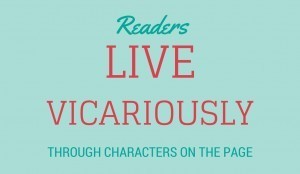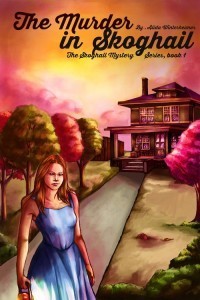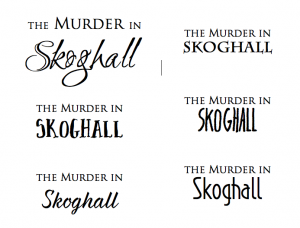Alida Winderhimer's Blog, page 2
January 25, 2015
Using Sensory Detail in Your Writing: The Trouble with the Green Screen
Alida Winternheimer, author
As humans, we rely heavily on our eyesight—unless you’re blind, of course—to record, comprehend, and navigate our world.
As writers, our job is to convey that world to our readers. To do this, we need to bring to life on the page that which is all around us in its full sensory glory.
The visual is the easiest to get down in ink. We grow up telling people what things look like, much more so than what they feel, taste, sound, or smell like.
Years ago I read an essay by a woman who was born without a sense of smell. She spent her life asking people to describe smells to her. Disappointingly, they always described one smell in terms of a similar smell. Then, she tells us, she was a first date with a man who told her the wine they were drinking smelled like when you put a grape in your mouth and you get that dry, puckering sensation, but when you bite into it your tongue is flooded with the juice inside that dusty skin. She fell in love with him then and there, and they married.
That story (I’m sorry I don’t remember who wrote it or where I read it) perfectly illustrates the power of capturing sensory details in your descriptive narrative. You do want your reader to fall in love with your work, right?
You’re nodding your head. That’s good. 
Now, there are two problems in this category I see over and over. We’ll call the category Using Sensory Details. We’ll call the problems 1 and 2.
1. People only write the visual and neglect the other four senses completely.
That one is easy enough to remedy. Put a sticky note on your computer or notepad that says, “What does it smell like? Taste like? Feel like? Sound like?” If you don’t write multiple sensory descriptions in the first draft, this will remind you to flesh out your story in revisions.
2. People focus on dialogue almost exclusively, neglecting the art of world-building. Manuscripts, and sometimes published books, read like they’re being played out against a green screen. Or like they’re a play script with stage directions framing blocks of dialogue.
The fix for this requires more than a sticky note. It requires careful attention to craft. It requires world-building from the ground up. Or space station out. No matter what kind of world you’re building, your characters will have some kind of senses they use to capture, record, and interpret that world. And if your characters don’t, your readers do!
Readers read in order to live vicariously through the characters on the page, to experience the worlds either strange or relatable that are not their own. To fail to develop that world is to do your readers a disservice.
I have a theory about why I’m seeing so much of this. It’s just a theory. I have no evidence either way.
So much of our media consumption is visual—TV, movies, web—that we are used to viewing worlds on a screen. And when we do, our focus is on the characters moving about and delivering dialogue. As such, we as a culture of story consumers, have learned to take for granted everything going on around the main actors.
Whether you’re sitting in the house at the Guthrie or the Cineplex, what is before you is the product of a creative team: set designer, props master, costume designer, sound engineer, etc. That is, everything going on behind and around the characters delivering the dialogue and bodily motions, has been carefully orchestrated to create an effect. To bring that world to life for the audience.
Imagine going to the theatre and the curtain going up on an empty stage. The actors entering in brown or blue cotton or wool sacks of a wardrobe. Maybe one has a hat. One has a beard. One wears a dress. They deliver their lines flawlessly, they emote beautifully. A decanter appears on stage out of nowhere and they pour themselves drinks. They discuss going to the lake, but nothing in the dialogue tells you if the fish are jumping or the snow is drifting across its icy surface. Now, this is not experimental. This is not black box. This is not radio. This is a full production.
Would you want your money back?
When you write a story, you need to be the set designer, props master, costume designer, lighting designer, sound engineer, etc. As the author, you must do it all. To neglect world building, is to leave your characters acting against the green screen. And you do that at your own risk.
How do we solve problem 2?
• Before you sit down to write that story, chapter, or book, do some freewriting exercises. Focus on the setting and keep the hand moving for 10 minutes or more. Don’t worry about characters, dialogue, or action. Just use your narrative skills to explore the world.
• Freewrite what something feels like, but don’t use labeling words. Challenge yourself. If a character is going to feel guilty, have her interact with some of the props in the scene, creating subtext through motions and objects, instead of using dialogue. Don’t use the words “feel/felt” or “guilt.” If your character is experiencing the taste of ice cream for the first time, make a list of all the words you’d use to explain to ice cream to someone, then write your scene without using any of those words. Challenge yourself to be original. Remember the woman born without a sense of smell?
• Read more stories, great stories, old stories, stories that carry you away to another time and place, that make you feel something deeply. Take notes about everything you notice, other than the dialogue. What have you learned about world building and sensory details by reading these stories?
• Watch a scene from a movie. Then watch it again with the sound muted. Then watch it again with the sound muted and study everything in the scene other than the main characters. Take notes. What have you learned about the world, the characters, the plot from what is happening around and behind the characters?
• Read more books. Did I already mention reading? Good. Read more.
The post Using Sensory Detail in Your Writing: The Trouble with the Green Screen appeared first on wordessential blog.
January 12, 2015
The 3-Act Structure
Alida Winternheimer, author
Do you really need a 3-act structure to tell a story? Why? What is each act about, anyway?
Those are the questions I address in this 10-minute video tutorial. Enjoy!
If you have questions or comments, please post them below.
The post The 3-Act Structure appeared first on wordessential blog.
November 10, 2014
Be Defenseless
Alida Winternheimer, author
Before I get to Be Defenseless, a quick share: the weekend was crazy busy: 2 literary events, my daughter’s birthday, my service dog’s public access test. It was nonstop.
The first event was a reading at The Loft for MN State Arts Board grant recipients. One of my best friends, Wendy Skinner, received a grant this year, and it was a thrill to hear her read one of her stories about the controversial wolf issue. The other event, a book launch for the New Annotated HP Lovecraft brought Leslie Klinger and Neil Gaiman to Minneapolis.
Why would I tell you this? Because both events energized me and in different ways. As a writer, we need to get out sometimes and be part of a community, support other writers, get inspired, and expand our dreams.
So go on…get out there.

Neil Gaiman
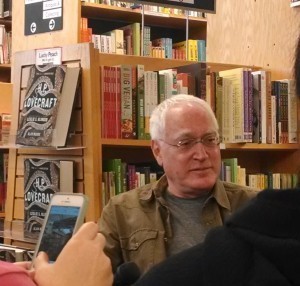
Leslie Klinger
When you ask for feedback from someone, be defenseless.
If you go looking for a reader’s opinion, whether that reader is a professional, a peer, or a lover of books, have the grace to accept whatever feedback you receive without defenses.
This is not to say every piece of feedback you receive will be good or useful to you. What I am saying is that once you put a work out into the world, you have to let it go. You will not be peering over your reader’s shoulder, explaining yourself. Each reader will respond to exactly what is on the page and nothing more. When a reader gives you poor feedback, consider what you put on that page to make him respond the way he did.
Maybe there is nothing you would do differently. Maybe that reader is an outlier, responding more to his own issue than to what’s on the page, but you won’t be able to draw that conclusion unless you keep your defenses down and honestly examine what you wrote in light of his honest response.
Workshops and serious critique groups set the rule that the author is not allowed to defend her writing. Typically, this means the writer is not allowed to speak during the work’s review and afterwards only to ask questions.
That is, the rule ensures you keep your defenses down.
I’ve been in workshops where writers weren’t able to abide by the rules.
During my MFA, I attended an intensive, residential workshop with Wells Tower. There were a few stories that were…not so good. One in particular was on the dissecting table and while people were trying to make sense of its various parts and contribute to a larger understanding of the specimen, there wasn’t much to recommend the piece. It was like the freak show mermaid: a dolphin’s tail rather tackily sewn to the upper half of a chimpanzee, and no matter how we looked at it, it just wasn’t quite right.
The writer, a woman who was not in the MFA program—which I say to partly excuse her, because she was not accustomed to the workshop process—couldn’t keep her quiet or her cool. She insisted that what she wrote on the page was exactly what had happened in real life. Many of us tried with varying degrees of sympathy to explain that real or not wasn’t at question. We were responding to what was on the page and she had not convinced us that her account was possible. It lacked verisimilitude. If she wanted readers to join her on her ride, she had to make it ring true. And in that she had failed.
Wells Tower calmly explained that this was a fiction workshop, and even if what she wrote was true, we were all correct in critiquing it as we would any piece of fiction. Her response was a vehement, “I wanted to take the creative nonfiction workshop anyway, but it was full!”
We didn’t bother to tell her that whether she labeled her story fiction or non, it would not stand before an attentive reader. Furthermore, her defenses had rendered pointless every bit of help we’d offered, so why offer any more?
When you receive feedback, it’s a gift. Accept it without any defenses. Examine it with an open heart. Only then can you decide if it’s bullshit…or if it’s you.
The post Be Defenseless appeared first on wordessential blog.
November 2, 2014
Covers & Fonts, Fonts & Covers
Alida Winternheimer, author
Do we really judge a book by its cover?
Yes, of course we do, which makes its design a major marketing and branding decision. I put it second only to the content on the pages. After all, someone might buy a book based on an attractive cover, but if the stuff between the covers isn’t all that good, he won’t recommend it to anyone or buy your second book.
I commissioned artwork for the illustrations in The Murder in Skoghall, including the cover. What I got back is great, but not cover material. My artist is an illustrator, not a cover designer, and the artwork looks like it belongs on a graphic novel, not a ghost story/mystery. As much as I liked the picture, I couldn’t use it as my cover.
Genre conventions and reader expectations count for a lot. Learn that now and hire professionals as needed.
This is the cover the illustrator did. Some of it is exactly what I want and some of it…not so much. Overall, it just doesn’t say ghost story/murder mystery. And the font is all wrong.
I’m obsessed with fonts. I love them. If I knew I was going to live a few hundred years, I’d enroll in a typography course and start designing my own. Given that I’ll probably live less than 300 years, I need to pick and choose how I spend my time, so I satisfy myself with admiring and buying other people’s font creations.
I’ve found some great font packages at creativemarket.com.
Because Skoghall is a series, the choices I make now will affect multiple books to come. I’m building a brand with this design. I want a special font for the cover that I can also use inside, for the chapter headers for instance.
The thing is, once my designer puts the title in the fonts I like onto the cover, they look too busy. Or they transform the carefully laid out ghost story/mystery cover into another genre entirely. It’s surprising how much difference a few letters can make. And it’s not. That is why this entire profession of typography exists, after all.
Each typeface has a different feel to it. Besides having to work with the cover art, it has to evoke the mood of the story. I rejected a font because it said “horror.” Another font that I loved on its own said “faerie folk” when it was placed on the cover.
It’s surprising how the shape of a few letters can completely change the feel of the cover.
See what I mean?
Here are a couple of examples of my new mock up from my designer, Rene at Phycel Designs.

Great font. Wrong colors.
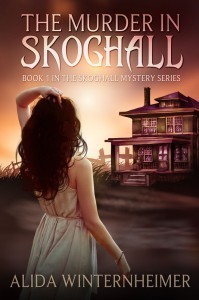
Says horror. Wrong genre.

This font makes me think faerie folk are going to come out of the trees.

This simplified font looks clean.
We’re getting close. What do you think?
The post Covers & Fonts, Fonts & Covers appeared first on wordessential blog.
October 22, 2014
Halloween Approaches
Alida Winternheimer, author
It must be time for Halloween. Found this on Twitter today:
Storm Cellar
@stormcellar
Bears, bears, and bears, oh my! http://bit.ly/1rgAQbw from SC 2.3, brief & #bloody #fiction by @alidawintern
That would be my short story, “Wild Animal,” being promoted as “bloody fiction.”
Oh my!
You can read it here.
It first appeared in Storm Cellar 2.3, a lovely little journal that appreciates a spattering of blood.
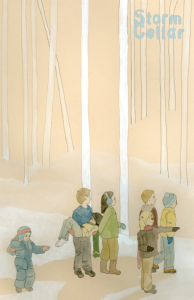
Storm Cellar
The post Halloween Approaches appeared first on wordessential blog.
October 18, 2014
Word Essential Workshop 4
Alida Winternheimer, author
This video is short, only 3 minutes. I get personal and make you a special offer. Now through Tuesday, you can take an online creative writing workshop with me.
Get 12 LIVE classroom hours, a bonus half-hour consultation, handouts, and recordings. Sign up before Tuesday.
The post Word Essential Workshop 4 appeared first on wordessential blog.
October 13, 2014
Word Essential Workshop 3
Alida Winternheimer, author
Today’s topic: the necessity of Forward Motion in your story.
This one is a little longer at 12 minutes. Despite some judicious editing, I couldn’t get it under 10. There’s just too much good stuff in there, including a diagram of my “What If? Game.” You might want to pause the video and look over the diagram in more detail.
I hope you enjoy this one!
If you missed them, go back and watch Workshop 1 or Workshop 2.
Want to follow along with the continuing adventures of Sara, intrepid teen?
Sara kept heading west as the suburbs thinned out, turning to the odd strip mall or townhouse development near the highway, then nothing but fields, lakes, and county roads intersecting the thoroughfare like offshoots to nowhere. She cranked up the music enough to hurt her ears and thumped the steering wheel to the beat and let the wind whip her hair into her face, lashing her eyes. The sun set low over the subtle swells of land and even with her visor down, she could hardly see for the glare across her dirty windshield. Sara knew she was a fool, speeding half-blind down a county highway. If a trooper didn’t stop her, she’d probably crash.
She didn’t care. Her recklessness felt like some kind of revenge.
Sara slowed, figuring her trooper waited behind the empty gas station that marked the outskirts of the next town. The sign said “Darwin, Minnesota. Home of the world’s largest ball of twine.” What the hell? Sara took the left toward First Street and found herself in a town square lined with shops, all of them either vacant storefronts or already closed for the day. The square consisted of a plot of grass dissected on the diagonal by two sidewalks that met at a structure in the middle. Sara parked in front of the empty ACE Hardware and got out of her car. She locked it, stared at the empty window, then shrugged as she pocketed her key.
The structure, a hexagonal shed, the kind people bought at Menards and plopped into their backyards, had Plexiglass panels on three sides so visitors could view the giant ball of twine. Sara leaned in close to a clear wall and cupped her hands between the Plexiglass and her face so the glare of the sun didn’t obscure her view.
One man’s obsession came in at 9 tons and 12 feet in diameter. Weird, Sara thought. One man could be dismissed as a kook, but the whole town took civic pride in this thing. Maybe it’s something in the water.
“If you come around this side, the sun will be behind the shed.”
Sara jumped, her hands fluttering before grasping at her chest.
A man, twenty-ish, with curly black hair and green eyes, smiled at her. “I didn’t mean to scare you,” he said.
She let go of her t-shirt and tugged its hem to smooth it out. “Then you shouldn’t have snuck up on me.”
“I didn’t sneak. I walked. You must really be into that twine to not have noticed.” He looked amused with himself.
“Just lost in thought,” Sara mumbled.
“The view is better on the other side. Did you know the twine killed the guy who made it?”
Sara put her hands on her hips. “You know a lot about this twine.”
“Not really.” His plain black t-shirt showed damp patches around the pits and middle of his chest. He wore jeans and heavy boots scuffed around the toes. Maybe these were work clothes. Maybe he just left a factory somewhere. “I read the sign,” he smirked.
Sara was in no mood to be treated like a child—there had been enough of that since the divorce started. “What are you doing here, anyway?”
“Stretching my legs.”
“Oh, right.”
He stopped smiling, and Sara observed the slight nod of his head as he scanned her up and down. She folded her arms over her chest and scowled, bracing for an insult. “Well, it’s been…” He turned and walked away.
Sara moved around the shed far enough to watch him round it and head across the square toward a motorcycle parked at the curb. A helmet and heavy jacket rested on the saddle of an old Nighthawk. He picked up his helmet and lifted it over his head. “Wait!” she yelled and ran across the square.
He leaned against his motorcycle while Sara caught her breath.
“I like your bike,” she said.
He smiled, bigger this time, and laughed. “Is that it? You ran over here to tell me you like my bike?”
“I… Can I have a ride?”
If you enjoyed this or learned something, leave a comment or question below and please share the link with your networks.
Happy Writing!
Alida
The post Word Essential Workshop 3 appeared first on wordessential blog.
October 8, 2014
Word Essential Workshop 2
Alida Winternheimer, author
Now that you know you should be in scene, here are some tips to help you with that.
Miss the first video? It’s here.
Want to follow along with the writing sample?
In scene, no dialogue:
Sara slammed her car door after hurling herself behind the wheel and instantly regretted it. The window had been slipping lately and her dad had pried the panel off the inside of her door to reset it twice already. She dropped her hands in her lap and stared at the vacancy that used to be her driver-side window. Her lower lip tucked between her teeth and she drew in a big breath. She exhaled between her teeth and lower lip: ffffff, then noticed her neighbor in the driveway next door. Mr. Anders raised a hand to wave hello, hesitated, and dropped his hand to his side. Sara liked Mr. Anders because he fed squirrels and had always given her a full size Snickers on Halloween just for living next door.
She couldn’t look at him and not burst into tears, so she jabbed her key at the ignition and jerked the old Civic into reverse.
She made it out of her neighborhood, staring resolutely out the windshield, refusing to glance to either side whenever she was stopped for traffic, certain anyone who saw her knew instantly that she was losing it.
With no money and too young to get into anywhere interesting, Sara got on Highway 12 and headed out of town. The one thing she could do was drive. A slew of CDs littered her passenger seat. With an angry shove, her back pack fell to the foot well. Sara shuffled through the silvered discs with her right hand, glancing between their labels and the pavement before her. Living in the burbs as she did, it wasn’t long before the highway dropped a couple of lanes and raised the speed limit. Sara pushed a Radiohead CD into the player, pressed the accelerator, and let the tears fall as the wind flew at her through the missing window.
If you enjoyed these videos or learned something, please leave me a comment or question below and share the links with your networks.
Happy Writing,
Alida
The post Word Essential Workshop 2 appeared first on wordessential blog.
October 4, 2014
Word Essential Workshop 1
Alida Winternheimer, author
So, you’re a writer.
But are you writing in summary when you should be in scene?
Note: You can read along with the example below the video and link to the RSP podcasts.
Get the recording of the Rocking Self-Publishing webinar here.
Get the Rocking Self-Publishing interview here.
Follow along with the example writing.
In Summary:
Sara bit her tongue, because she didn’t want to get in the middle of her parents’ fight again. Last time she tried to speak up, it didn’t go so well for her. She was trying to not hate her dad, but since the divorce began, he seemed like such a jerk.
In Scene:
Sara’s parents were yelling again. She didn’t know how long they’d been at it this time, because she’d just got home. She dropped her back pack and kicked the door shut, ensuring it would slam loudly enough to rattle the walls.
Her parents stopped yelling long enough to shift their glares from each other to her. Sara felt the back of her neck turn pink under such heated stares.
“I can hear you outside, you know. The whole neighborhood can hear you,” she shouted.
Her mother dropped her gaze. Was that shame? Sara had never seen her mother look so undone.
“Sara,” her father began.
“No! I don’t want to hear it.” She hadn’t meant to borrow his favorite line; it slipped out. “You’re a liar and a cheater and…” Sara had no idea how her father managed to cross the great room so fast. She hadn’t even registered his approach. She registered the slap across her face, and a moment later her mother, still across the room, bug-eyed with both hands over her mouth. Sara grabbed up her back pack and did an about face.
This time she didn’t bother closing the door.
If you have any questions or comments, please share them below.
Happy Writing,
Alida
P.S. Watch for the next video, in which I’ll tell you how to write in scene.
The post Word Essential Workshop 1 appeared first on wordessential blog.
October 3, 2014
A Brief Overview of Point of View
Alida Winternheimer, author
Face it, we could fill a graduate seminar with Point of View; it’s that complex a matter. So I was being silly when I went to teach on Wednesday, and I thought I’d just give a brief overview of POV, then move on to the Plot unit.
The students had lots of questions. Some questions they didn’t know they had until I started talking, like “what’s the difference between close and distant?” Or, “how is multiple third different from omniscient?”
POV is something a lot of writers do instinctively. They start telling the story without a clear understanding of the craft involved in POV.
What’s wrong with that?
Nothing if said writer’s instincts are acute. But for the typical writer, there’s a lot wrong with that. POVs get sloppy. Manuscripts are a mishmash of multiple third and omniscient with ugly transitions and no clear signal to the reader that a switch is about to occur. Distance is not controlled, so the writer misses opportunities to heighten dramatic tension and reader engagement by getting in close with the character. And many writers are favoring multiple third, when a single or double close third would tighten the story and add suspense, overall increasing reader empathy with the main character.
Have I convinced you it’s worthwhile to learn about POV?
I’m going to give you the brief overview of POV that I gave my workshop students, then—just like they did—I’d love it if you typed your questions in the comments below.
POV combines three principle elements: number, person, and distance.
Number = the number of characters with a POV, usually defined as single or multiple.
Person = the character(s) through which we experience the story world and events.
Defined in terms of the pronoun used. E.g. Third person uses he, she, they.
Distance = the emotional distance between the narrator and the POV character(s).
First Person narrative (I, we) is about as close to the story as you can get, because the POV character functions as the narrator as well.
Second Person narrative (you) is difficult and rarely used. It functions best in short pieces, because it can become tedious to the reader. You can read a second person short story here.
Third Person narrative (she, he, they) is the most common POV.
Omniscient narrative (often confused with multiple third) is also difficult and seldom used in modern literature—it was more common in 19th and early 20th century works. Omniscient is distinguished from multiple third by the all-knowing narrator who is not bound by person, time, or space.
To factor in the distance, attach “close” or “distant” to any of those POVs, as in “close third” or “distant omniscient.” Are we looking through a character’s eyes, or at a character from above? A good analogy for distance is to think of the narrator as represented by the camera lens in a movie. Is the lens zoomed in or out?
Now that you’ve had an overview of the elements of POV, type your questions below. I’ll do my best to answer them all!
The post A Brief Overview of Point of View appeared first on wordessential blog.

